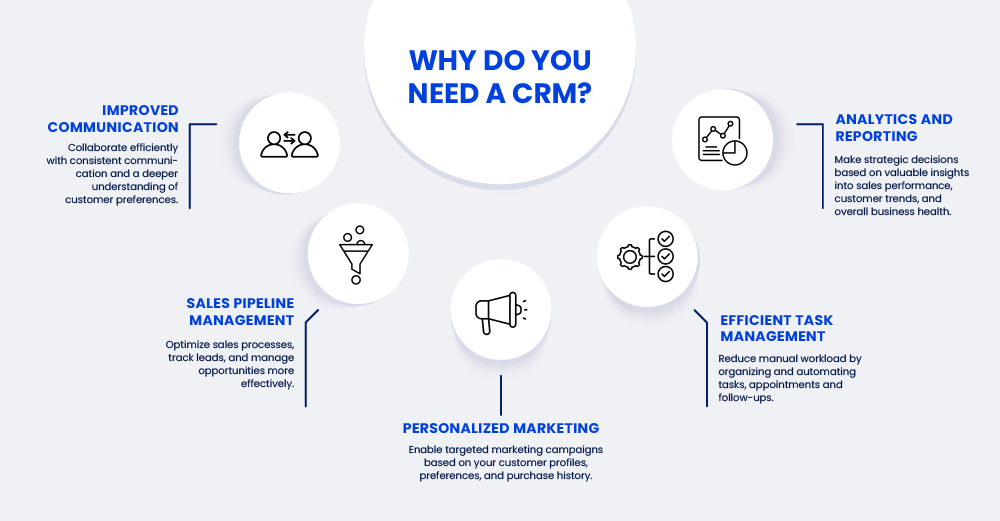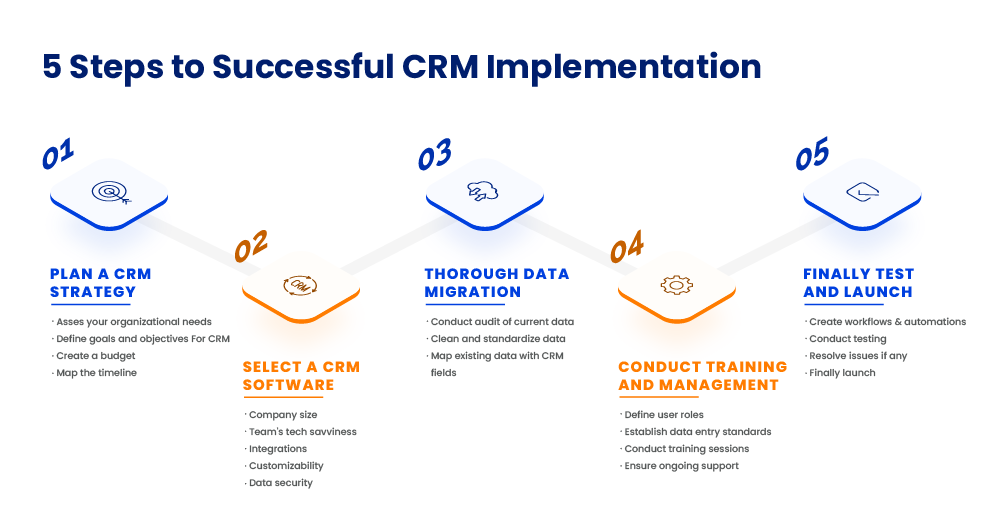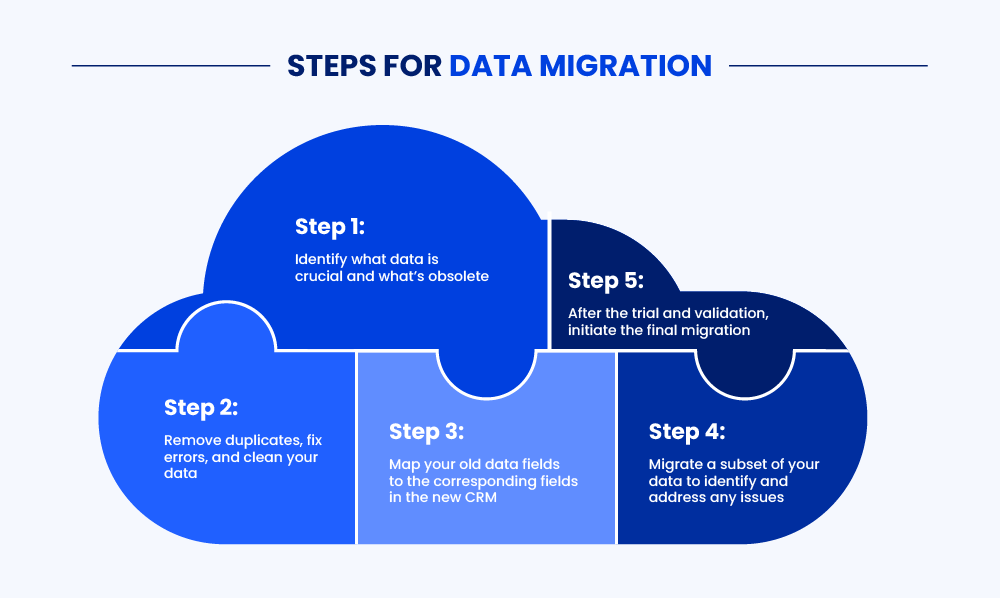Over the past two years, more and more organizations are investing in CRM implementation. It’s not just a trend; it’s practically a business essential now.
But implementing a Customer Relationship Management system just for the sake of it isn’t going to help anyone. You won’t be able to take advantage of the full capabilities of a CRM.
So, it is crucial to have a clear plan, involve your team, and make sure you’re using the CRM to its full potential for it to truly benefit your business.
In this article, we’ll discuss the five steps for flawless CRM implementation and the post-implementation steps for a smooth run.
What is CRM Implementation?
CRM implementation is the process of applying the customer relationship management strategy and tools within a company. This includes installing the CRM software, customizing it to fit the company’s needs, training employees on how to use it. Moreover, it involves integrating it into the daily operations to enhance customer interactions and relationships.
A CRM implementation will help you smooth out the blockages, automate workflows, and manage your contacts effortlessly. Implementing new software can be a daunting and time-consuming task. So, let’s look at a critical question you need to ask yourself.
Do you need a CRM?

The short answer is YES.
The longer answer is, of course, yes.
But seriously, here is why you need a CRM:
- Improved communication– With a CRM, your team can collaborate efficiently, ensuring consistent communication with a deeper understanding of customer preferences, behaviours, and history.
- Sales pipeline management– A CRM can optimize their sales processes, track leads, and manage opportunities more effectively, leading to increased sales and revenue.
- Personalized marketing– CRM tools enable targeted marketing campaigns based on your customer profiles, preferences, and purchase history, enhancing the effectiveness of marketing efforts.
- Efficient task management– It also helps your teams organize tasks, appointments, and follow-ups, reducing manual workload and ensuring timely customer engagement.
- Analytics and reporting-CRM analytics provide valuable insights into sales performance, customer trends, and overall business health, aiding strategic decision-making.
So, whether you are an enterprise or a small business, CRM implementation can be a complete game changer for your sales and marketing efforts. Let’s understand how you can implement a CRM in five easy steps.
5 Steps to Successful CRM Implementation

1. Plan a CRM strategy
To ensure your CRM implementation is a success, there are certain steps you need to take. Think of it as laying a solid foundation for your success.
a. Asses your organisational needs
Firstly, understand your business needs and see how CRM aligns with them. Identify the specific processes and workflows that can be automated using a CRM.
Examine your data and its quality- clean and accurate data is the backbone of smooth CRM implementation.
b. Define goals and objectives for CRM
A CRM can solve multiple problems for your business. It’s like a Swiss Army knife of solutions. But some CRMs solve some issues better than others. So, it would help if you prioritized what features are a deal breaker for you to achieve those goals.
c. Create a budget
It is essential to be realistic while creating a budget for implementation. To stay on track, you should regularly review and adjust them as the implementation progresses.
There are multiple costs involved. Identify any additional tools or services you need based on your goals. Consider the implementation costs, such as training and data migration.
Also, factor in ongoing expenses like licensing and support. Moreover, create an emergency fund for any unexpected expenses you might have.
d. Map the timeline
The timeline of implementation depends on multiple things and people. Identify critical milestones like user training, customizations, etc. Break these down into smaller tasks and estimate the time needed. You can prioritize tasks based on dependencies. Consider factors such as team availability and external support. Define the stakeholders for each step.
Remember to build buffer time for any unexpected delays. Most importantly, communicate the timeline clearly to your team and regularly check progress.
2. Select a CRM software
Choosing a CRM is like finding the right puzzle piece for your business. Use the goals list created earlier and map them to the features you need to fulfill them. Besides that, consider factors like team size, industry-specific features, and integration capabilities. Your team’s tech savviness also matters. Opt for a system with a user-friendly interface and zero or low code required.
Also, check if the CRM is customisable to your business needs. Existence of thorough training material and support staff is essential to ensure a smooth transition. Data security and compliances are equally critical for protection of your confidential information.
Checkout for customer reviews on review sites like G2, Capterra, and Gartner to get insights into performance and challenges. Customer testimonials with a similar use case as yours can also give you deeper insights.
Scalability is often overlooked but vital. Your business will grow, and your CRM should be able to grow with it. In essence, it’s a balancing act – find a CRM that meets your current needs while being flexible enough for the future.
Here’s a checklist you can use to select the right CRM for your business.
3. Thorough data migration

Once you have selected a CRM system to be implemented, it’s time to move your data. You can follow the following steps to do so:
- Begin by taking stock of your data. Identify what’s crucial and what’s obsolete. Plan how you’ll structure the data in the new CRM, considering fields, relationships, and user access.
- Like tidying up before a move, clean your data. Remove duplicates, fix errors to ensure uniformity across data.
- Map your old data fields to the corresponding fields in the new CRM. It’s like labelling your moving boxes so that everything goes to the right place.
- Before the official move, do a trial run. Migrate a subset of your data to identify and address any issues. After the trial, verify the integrity of the migrated data.
- It’s the big day – moving your data to its new home (CRM). Once you’re confident after the trial and validation, initiate the final migration.
Remember, attention to detail and thorough planning can make the CRM data migration a seamless process.
4. Conduct training and change management
When rolling out a new CRM system, it’s crucial to blend training and change management seamlessly. Start by identifying key stakeholders and their concerns. Foster a supportive environment where your employees feel comfortable asking questions and seeking help.
Use training modules to familiarize the users with features, integrations, and reports. Set standards for data entry and updates for better results. Tailor your training sessions to each type of user to convey the full benefits.
In terms of change management, communicate the reasons behind the CRM implementation clearly. Highlight the positive impact on daily workflows and overall efficiency. Address any resistance by showcasing success stories and providing ongoing support.
Encourage a culture of adaptability, emphasizing that the CRM is a tool to streamline processes rather than an additional burden. Regularly gather feedback to refine your approach and make necessary adjustments.
5. Finally test and launch
Finally, implement all the custom workflows and automation. Also, integrate your existing systems to create a seamless flow of data. Conduct rigorous testing for each of your custom APIs to make sure they are working.
For maximum data protection, create permission templates based on different user roles, regions, and hierarchies. For example, have the leads assigned to a sales user only visible to them and their supervisor.
Run a beta test with a small team and take feedback for any tweaks required. It is essential to plan your go-live in phases. Rolling out CRM in phases allows your team to ease into using the new system.
Finally, launch your CRM!

Download now, to make your CRM implementation a smooth sailing process (PS: it’s clickable)
But the work is not done yet. There are also a few post-implementation steps you need to take for the overall maintenance and hygiene of your CRM in the long run.
Post Implementation Steps
1. Post implementation evaluation
After you implement a CRM, it is crucial to conduct an evaluation. It involves assessing how well the CRM is performing and making any necessary adjustments. This usually includes the following:
a. User feedback
Gather feedback from users about their experience with the CRM. Understand their challenges and what features are working well. Evaluate the level of user adoption within the organization.
If the adoption rate is less, identify what is holding them back. Don’t leave your team hanging after the initial rollout. Provide ongoing support, whether through regular check-ins, additional training sessions, or an easily accessible help desk. Knowing help is readily available can boost confidence.
b. Functionality assessment
Evaluate if the CRM is meeting its intended functionality. Measure them with key performance indicators (KPIs) . Assign these indicators for each of your goals and measure them regularly. For example, check if there has been an increase in net promoter score (NPS) post-implementation.
c. Customization and integration effectiveness
Assess how well the CRM is integrating with the other systems. If there are any issues, connect with the CRM account manager to look for alternative solutions. Check what customizations are working and being used the most. Evaluate ways you can get the most out of the system.
2. Establish a feedback loop
Maintaining a CRM is an ever-evolving process. There is always more you can do as you scale higher, and your team gets better. Therefore, it is important to set up a feedback loop with your team. Have cadences with your team at regular intervals to understand what more can be achieved.
You might have started with a small number of users. Look at whether you need to upgrade your plan. On the other hand, it could also be the system you chose is not working out well. If that’s the case, evaluate what issues, if resolved, will make it compatible with your business plan. If your current CRM is unable to offer that, look for alternatives.
Conclusion
In conclusion, CRM implementation is not just a technological upgrade; it’s a strategic move that can reshape how you manage customer relationships and drive business success. From improved communication and streamlined sales processes to personalized marketing and efficient task management, a CRM is a versatile tool that caters to diverse business needs.
The five-step guide emphasizes the importance of careful planning, software selection, meticulous data migration, practical training, and thorough post-implementation evaluation. Remember, your journey doesn’t end with the CRM launch – establishing a feedback loop ensures ongoing optimization and scalability.
So, if you’re wondering how to get started, follow the steps outlined, and you’re on your way to leveraging the full potential of CRM for sustained business growth.
Also, if you are looking for a CRM that takes on your business challenges with ease and is low code at the same time, ou should definitely consider LeadSquared. It is a versatile and extremely customizable CRM with out-of-the-box integrations.
Book a personalised call to know more about how LeadSquared can help you.
FAQs
The average cost of CRM implementation varies widely, it could range from free to several hundred thousand dollars. It is based on factors such as:
1. Size of business
2. Number of users
3. Customisations
4. CRM system
5. Integrations
6. Add-ons
7. Maintenance cost
The following are the list of best CRM software:
1. LeaSquared
2. Salesforce
3. Pipedrive
4. HubSpot
5. Agile CRM
6. Zoho CRM
7. Keap CRM
8. Salesmate CRM
Yes, many consulting firms help with CRM implementations by understanding your industry, business problems and create a tailored solution for your organization.









